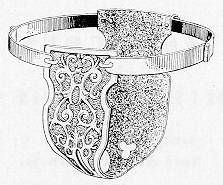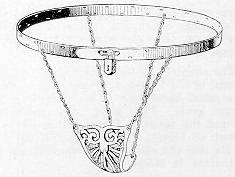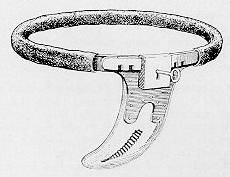

Scans by: Sting
It was, however, in the middle ages that the extensive use of these girdles became popular. The reason was an obvious one. A lord or duke under the feudal system then existing was compelled by the rules of the order to which he belonged to wage war against the Turk or Saracen in the Holy land in an attempt to free Palestine from the infidel. These wars or crusades lasted for years, and it was no uncommon thing for a knight to be away from his home for many months at a time, and often he was away for a space as long as two or three years. Human nature being what it is, it was natural for these men to wonder concerning the conduct of their wives while they were thus away, and it is obvious that they could not help but be disturbed with thoughts of jealousy concerning the bride whom they had left back in the castle. They devised many ways of protecting their wives, most of which took the form of belts or bands that passed around the waist and were sometimes locked with padlocks and at other times sealed with the knight's own seal, or even welded together.

As a rule they were of iron or bronze, but many instances are known where precious metals were used. In the Dialogs of Luisa Sigea, Tullia's husband says:
Francesco II de Carrara, the last Sovereign Lord of Padua, in some histories is given as the inventor of the chastity belt, although more ancient records of this device have been found. At any rate, Dulaure states in his chronicle that one of the charges against Francesco at the time of his trial was that he put padlocks and girdles of chastity on all the women in his Seraglio, and that a chest full of these tools were preserved long after they had served as so many convincing proofs at the monster's trial. He was eventually strangled in prison by a political enemy.

The simplest girdle on record is that preserved in the Musee de Cluny, Paris, which is a metal band onto which is fastened an ivory beak. The band was protected by a sheath of velvet. Tradition states that this girdle was one which Henry II put on Catherine de Medici.

Nicholas Chorier describes another girdle which was simply a grating of gold suspended from a belt by four small chains. Two of the chains were welded and fastened to the girdle in front, while the other two were fastened in back.
The catalog of the Musee de Cluny describes another girdle as composed of two plates of forged iron, engraven, damaskeened and pinked with gold, united at the bottom by a joint and at the top by a girdle of wrought iron. There were holes around the edges of the plates and girdle for lining to be sewed on. The figures of Adam and Eve are engraven on the forepart, and the padlock is placed behind at the side.
An apocryphal account has it that Napoleon before his Egyptian campaign attempted to fasten a girdle of this type onto Josephine, with results that were not entirely satisfactory to France's future emperor.
Voltaire in his "Tale of the Padlock" mentions a girdle of chastity which was solidly bolted around the body of Madame de B., and throughout literature we find other references to these historical devices.
It is interesting to note, however, that we still see occasional references to the use of these garments, and while their general application has certainly fallen into disuse, there are isolated cases, some of which have appeared in newspapers, which tell of the continued use of chastity girdles by husbands whose unfounded jealousy amounts almost to a mania.
The Medieval Torture Chambers were conceived, designed and built by Messmore & Damon. Here are shown the actual tortures of the Middle Ages in life-like, moving, breathing, talking figures. In addition the Chastity Belt described in this folder is also shown.
[ Back to female chastity page ]
Page last updated 98-Sep-15 by: Altairboy@aol.com